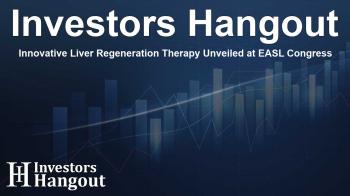Innovative Liver Regeneration Therapy Unveiled at EASL Congress

Discovering Innovations in Liver Regeneration
The scientific dialogue around liver health and regeneration is gaining momentum, particularly with the promising advancements at HepaRegeniX. At a notable congress, the foundation of a new chapter in liver therapy was outlined, showcasing exciting developments that focus on revolutionizing treatment approaches for liver diseases.
Prof. Lars Zender's Insights on HRX-215
During a significant plenary session at a major European liver health conference, associated with the European Association for the Study of the Liver, Prof. Lars Zender, a leading figure in liver science, unveiled critical findings on HepaRegeniX's lead molecule, HRX-215. This presentation not only emphasized the drug’s potential for enhancing liver regeneration but also delved into its path from conception through to initial trials.
The Journey of HRX-215
Prof. Zender’s discussion highlighted the stages of drug development, starting from the original discovery of the small molecule HRX-215, which is designed to inhibit MKK4, a crucial protein in the liver regeneration pathway. The evidence presented suggested that this small molecule helps to stabilize liver cells, thereby supporting regeneration even in impaired livers. The data showcasing the drug’s efficacy came from a pig model, where HRX-215 led to improved survival rates following substantial liver resections.
Clinical Relevance and Future Trials
Currently, HRX-215 is advancing through Phase Ib clinical trials with the objective of preventing liver failure after surgeries. The results so far have suggested a favorable safety profile and effective pharmacokinetics, positioning it as a beacon of hope for both patients and medical professionals facing severe liver ailments.
A Transformative Therapeutic Approach
Both Prof. Zender and Elias Papatheodorou, the CEO of HepaRegeniX, reinforced the therapeutic significance of HRX-215, noting its potential to enhance the safety of oncological liver surgeries and providing solutions in liver transplantation scenarios. This therapy embodies a revolutionary approach to liver treatment, aiming to utilize the intrinsic regenerative capabilities of the liver more effectively.
Collaboration and Funding Success
Advancing HRX-215’s clinical journey is a testament to the collaborative spirit among HepaRegeniX’s team and its partners. The recent successful Series C funding round positions the company strategically for the next steps in its research and development endeavors, including vital Phase IIa trials. Investing in such innovation clearly illustrates HepaRegeniX's commitment to tackling critical liver health issues.
The Significance of EASL Congress in Liver Research
The European Association for the Study of the Liver Congress serves as an essential platform for the exchange of cutting-edge liver research, providing a stage where leaders in the field can discuss transformational findings. The State-of-the-Art lecture such as Prof. Zender’s is vital in keeping the global community informed and engaged with the latest scientific advancements.
About HepaRegeniX GmbH
HepaRegeniX is at the forefront of developing therapies for liver diseases, leveraging novel cellular targets and molecular innovations. With HRX-215 currently positioned to address critical health challenges like post-hepatectomy liver failure and severe alcohol-associated hepatitis, the company aims to harness the liver's regenerative potential more effectively. Further, the pipeline includes HRX-233, aimed at overcoming treatment resistance in certain cancers, highlighting HepaRegeniX’s broader ambitions.
Frequently Asked Questions
What is HRX-215?
HRX-215 is a small molecule developed by HepaRegeniX targeting MKK4, which plays a pivotal role in liver cell regeneration.
What clinical stage is HRX-215 currently in?
HRX-215 is undergoing Phase Ib trials aimed at preventing liver failure after surgical procedures.
Who presented the findings on HRX-215?
Prof. Lars Zender, co-founder of HepaRegeniX, presented the findings during a plenary session at a liver health congress.
What are the potential benefits of HRX-215?
HRX-215 may improve liver regeneration, enhance surgical safety, and support living donor transplant success.
How is HepaRegeniX funded?
HepaRegeniX is backed by a range of reputable life science investors, ensuring robust funding for their innovative projects.
About The Author
Contact Evelyn Baker privately here. Or send an email with ATTN: Evelyn Baker as the subject to contact@investorshangout.com.
About Investors Hangout
Investors Hangout is a leading online stock forum for financial discussion and learning, offering a wide range of free tools and resources. It draws in traders of all levels, who exchange market knowledge, investigate trading tactics, and keep an eye on industry developments in real time. Featuring financial articles, stock message boards, quotes, charts, company profiles, and live news updates. Through cooperative learning and a wealth of informational resources, it helps users from novices creating their first portfolios to experts honing their techniques. Join Investors Hangout today: https://investorshangout.com/
The content of this article is based on factual, publicly available information and does not represent legal, financial, or investment advice. Investors Hangout does not offer financial advice, and the author is not a licensed financial advisor. Consult a qualified advisor before making any financial or investment decisions based on this article. This article should not be considered advice to purchase, sell, or hold any securities or other investments. If any of the material provided here is inaccurate, please contact us for corrections.

